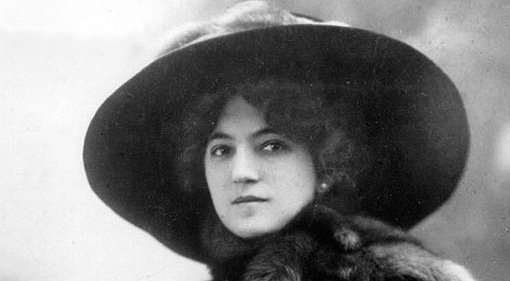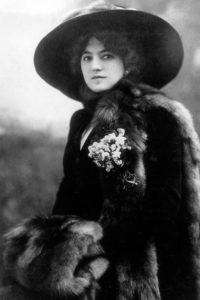 Historical recordings provide an invaluable opportunity to hear the artistry of performers trained in the 19th century tradition of composers whose music we still revere today. While some composers actually recorded their own works themselves – notably those active in the 20th century, like Rachmaninoff, Prokofiev, Stravinsky, Poulenc, Gerswhin – the technology developed too late to hear the greats like Chopin and Liszt performing, although the students of Liszt made many recordings and grand-students of Chopin have set down dozens of hours of performances.
Historical recordings provide an invaluable opportunity to hear the artistry of performers trained in the 19th century tradition of composers whose music we still revere today. While some composers actually recorded their own works themselves – notably those active in the 20th century, like Rachmaninoff, Prokofiev, Stravinsky, Poulenc, Gerswhin – the technology developed too late to hear the greats like Chopin and Liszt performing, although the students of Liszt made many recordings and grand-students of Chopin have set down dozens of hours of performances.
When it comes to Brahms, the composer made two cylinder recordings at the keyboard which have unfortunately deteriorated so severely that one can get a glimpse of the spirit with which he played more than specific details. But fortunately there are recordings of those who knew him from which we can learn about how his music was performed in his lifetime. The great Carl Friedberg was a marvellous exponent of his tradition (he will be the subject of a future blog post), but among the most fascinating pianists to record – albeit far too little (indeed, much less than Friedberg) – is the brilliant Hungarian-born virtuoso Ilona Eibenschütz.
Born on May 8, 1873 (not 1871 or ’72 as has generally been written), Eibenschütz as a prodigy had played for Liszt, who was very impressed and interested in her future. Because he was too old to take her on as a pupil, the famed pianist-composer suggested she go to Vienna. Ilona would become the youngest student at the Vienna Conservatoire, at the same time that Fritz Kreisler was a pupil there (the two became friends and the stars of the institution). At the age of 9, she played Mozart’s D Minor Concerto with the Vienna Philharmonic, still so small in stature that a contraption had to be connected to the pedals so that the diminutive child could pedal effectively. When asked if she liked the piano, Ilona reportedly said “It’s quite nice, but couldn’t I have a Bösendorfer?” Her discerning taste won her the Vienna-based Bösendorfer’s loyalty, and in the future the master piano maker would provide Eibenschütz with pianos for her concerts.
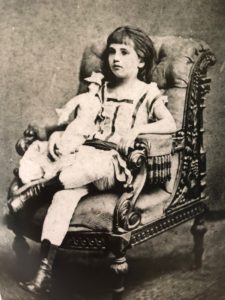 After a few years in Vienna it was decided that Ilona should study with a great pianist, but Liszt being too old and Anton Rubinstein, who wished to teach her, traveled too much to teach with the consistency she required, Clara Schumann was chosen as her mentor. Frau Schumann could clearly see the young Ilona’s talent but did not immediately agree to teach her: she noted that as she had already had great success, she was concerned that the young girl would not “be willing to submit to my teaching, as I should want you to alter in some important respects.” Ilona reportedly promised to do exactly as she was told if she were accepted.
After a few years in Vienna it was decided that Ilona should study with a great pianist, but Liszt being too old and Anton Rubinstein, who wished to teach her, traveled too much to teach with the consistency she required, Clara Schumann was chosen as her mentor. Frau Schumann could clearly see the young Ilona’s talent but did not immediately agree to teach her: she noted that as she had already had great success, she was concerned that the young girl would not “be willing to submit to my teaching, as I should want you to alter in some important respects.” Ilona reportedly promised to do exactly as she was told if she were accepted.
And so Eibenschütz spent five years with Clara Schumann, and while the fiery young Ilona of course benefitted greatly from her training with her stern teacher, her staunch individuality and bold pianism did not lend itself particularly well to all of her teacher’s more traditional preferences (she would insist on seeing the dresses her pupils planned to wear at their concerts). Clara would admonish her for playing too quickly and for not focusing on details, writing in CAPITAL LETTERS to emphasize how Ilona needed to be more diligent. For example: “I have told you so often of my fear that because of the ease with which you learn you are tempted not to practice CONSCIENTIOUSLY ENOUGH. I COULD PROVE THIS TO YOU IN EVERY PIECE WHICH YOU PLAYED YESTERDAY and would like to go through them all once more with you.” Prior to an 1891 performance in London, Frau Schumann warned her, “You must heed this very carefully: BE PRECISE AND METICULOUS with everything even to the smallest detail.”
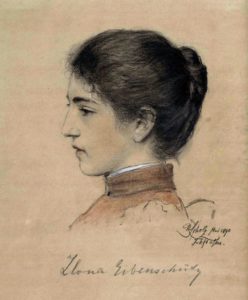 The year after these admonitions, Eibenschütz was deemed by Frau Schumann ready to make her mature debut recital in Vienna at the age of 19, at which the central works were Beethoven’s Sonata Op.111 and Schumann’s Etudes symphoniques. Her playing in a wide range of repertoire would be celebrated over the course of the next decade: her Beethoven Fourth Concerto with Richter shortly before her marriage – one of her final performances in Vienna – was so well received that the audience insisted that the slow movement be repeated, and when Frederic Lamond met her after a 30-year break, he apparently rushed towards her arms open saying ‘The F Minor! The F Minor!’ in remembrance of her glowing reading of Chopin’s Second Concerto decades earlier.
The year after these admonitions, Eibenschütz was deemed by Frau Schumann ready to make her mature debut recital in Vienna at the age of 19, at which the central works were Beethoven’s Sonata Op.111 and Schumann’s Etudes symphoniques. Her playing in a wide range of repertoire would be celebrated over the course of the next decade: her Beethoven Fourth Concerto with Richter shortly before her marriage – one of her final performances in Vienna – was so well received that the audience insisted that the slow movement be repeated, and when Frederic Lamond met her after a 30-year break, he apparently rushed towards her arms open saying ‘The F Minor! The F Minor!’ in remembrance of her glowing reading of Chopin’s Second Concerto decades earlier.
Despite seeming destined for a remarkable career, Eibenschütz retired from the concert platform shortly after her 1902 marriage to Carl Derenberg at the age of 30 and moved to London. She would give the occasional performance – she played publicly with the Rose Quartet in 1913 and at private events with fellow Clara Schumann pupil Adelina de Lara – but by and large her performing career had come to an end. She made a handful of commercial discs in 1903, about half of which were published, and in them we can hear her bold, vivacious, tempestuous playing, with rapid tempi, dazzling finger work, and rhythmic vitality.
Ilona Eibenschütz: The Complete 1903 G&T Recordings
December 16, 1903
Scarlatti Sonata in E Major K.20
Scarlatti Sonata in G Major K.14
(matrix 4710b – disc 5558)
Brahms Ballade in G Minor Op.118 No.3
(matrix 4712b – disc 5559)
December 22, 1903
Brahms Waltz in E Major Op.39 No.2
Brahms Waltz in A-Flat Major Op.39 No.15
(matrix 4755b – unpublished)
Ilona Eibenschütz, piano
Fred Gaisberg, producer
Eibenschütz remained active in social and musical circles her entire life, and a fascinating encounter took place in April 1948 when word reached Dinu Lipatti that a former pupil of Clara Schumann wished to meet him. Lipatti wrote to his teacher about the evening he spent with the pianist at her friend’s home – it may have been her close associate Eva Ducat, who was very dedicated to Ilona’s cause and who met Gregor Benko (co-founder of the International Piano Archives) in London in the late 1960s/early 1970s, dressed in full Victorian garb, complete with wide-rimmed hat and a bustle (Ducat was born in 1878 and died as late as 1975).
Lipatti stated that he had “always avoided the type of person who passes on the so-called ‘tradition’ of the great masters, over the years, and ends up with a completely distorted version of their personal messages. Great was my surprise to discover, on the contrary, that in spite of her age, this woman plays the piano divinely and has a prodigious memory. She kept us spellbound for more than three hours playing many pieces by Schumann, Brahms, Scarlatti, and others. I was surprised by the freedom in her playing, despite using very little rubato. I played to her Schumann’s Etudes symphoniques and she told me some very interesting things. She was in London during the whole of the Blitz. Her house was hit by a bomb, and she was saved by a staircase under which she had crept clutching her only treasure – the letters from Clara Schumann and Brahms! Very moving!” Alas, no photographs of this meeting between Eibenschütz and Lipatti have been found.
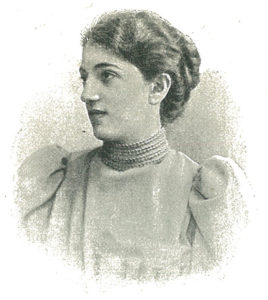 While her tutelage with Clara Schumann would seem to be a major highlight of her musical career, it was in fact a relationship that took root during her studies in Frankfurt that would mark Eibenschütz’s musical life forever: her encounters with Johannes Brahms. Ilona was about 16 when she first met the already legendary composer at Frau Schumann’s, and a strong sense of mutual admiration would ensue. Of course Ilona adored the composer’s works and for his Brahms was very taken with Ilona’s character, striking appearance, and playing.
While her tutelage with Clara Schumann would seem to be a major highlight of her musical career, it was in fact a relationship that took root during her studies in Frankfurt that would mark Eibenschütz’s musical life forever: her encounters with Johannes Brahms. Ilona was about 16 when she first met the already legendary composer at Frau Schumann’s, and a strong sense of mutual admiration would ensue. Of course Ilona adored the composer’s works and for his Brahms was very taken with Ilona’s character, striking appearance, and playing.
Brahms visited with Eibenschütz’s family in Ischl (he adored her mother’s cooking) and on one visit in 1892, he showed up with some pieces he had just composed, which turned out to be his Opp.118 and 119, and he played them for her from the manuscript… what an experience for someone still in her teens! Ilona would champion these works, giving them their first public performance in London shortly afterwards. Brahms said that he liked Eibenschütz’s playing above everyone else’s.
In 1952, Eibenschütz recorded a testimonial of her friendship with Brahms for the BBC that is of astounding historical importance. While her account is scripted (it was in fact a text she had penned and published in the 1920s, and one can hear her turn pages and occasionally misread a word), the freshness of her sharing of these incredible encounters is an absolute delight. What an gift to be able to hear the voice of someone who knew the legendary Brahms telling personal stories that could have so easily disappeared into the ethers without being documented.
And then there is the playing: aged 80, Ilona still played with great facility (as Lipatti reported a few years earlier) and with tempi that would today be seen as far too fast: she plays an excerpt of Brahms’ Fourth Ballade Op.10 at double the speed one generally hears. What tremendous insight one gains from hearing someone who knew the composer, for whom this was NEW music, as opposed to (as Lipatti said) a tradition that needs preserving and ends up being distorted by exaggerated and displaced reverence, which removes a sense of present-time aliveness. While Clara found her tempi too quick, Brahms adored her playing – can we not take this as approval of her approach?
Ilona Eibenschütz reminisces about Brahms (1952)
In this clip we can hear at 0:51 an excerpt of the second movement of Brahms’s Trio in C minor Op.101, and at 9:44 a portion of his Ballade Op.10 No.4 in B Major. The performance of Brahms Op.119 No.2 that Ilona introduces at the end of her narration is not present, but a private recording can be heard here (at 3:17, after a lovely reading of Schumann’s Romance Op.28 No.2):
Ilona Eibenschütz plays Schumann’s Romance Op.28 No.2 and Brahms’ Intermezzo Op.119 No.2
In the 1950s, Eibenschütz made private recordings at home, only some of which have been issued, which capture her vital, lively pianism. Here is one of those private recordings of Brahms, issued on two separate Arbiter releases featuring artists who knew that composer (both highly recommended): the Brahms Intermezzo in B-Flat Major Op.76 No.4, featuring a soaring singing melodic line, remarkable rhythmic freedom that somehow never sacrifices the pulse, wonderful voicing of chords, and magnificent interplay between primary and secondary voices:
Ilona Eibenschütz plays Brahms Intermezzo in B-Flat Major Op.76 No.4
A special upload made available here for the first time: Schumann’s Arabeske Op.18, played without repeats and at a tempo that might have upset Clara, but which is exceedingly beautiful for its lovely singing line, wonderful communication between primary and secondary voices, and gorgeous rich tone that is appreciable despite the less-than-ideal sound of the amateur recording. What a shame this artist retired from the platform and left so few recordings, despite dying as late as 1967 at the age of 95 – but what a joy and privilege to be able to hear anything at all from an artist who was so closely aligned with key figures of Romantic pianism.
Ilona Eibenschütz plays Schumann’s Arabeske Op.18
And finally, a filmed interview I conducted with Eibenschütz’s grandson Oliver Robinow in 2021, in which he discusses his grandmother from his personal experiences meeting her. This presentation also includes photographs, programmes, autographs, and recordings – including excerpts of some that have never been released – and is a fascinating exploration of this truly remarkable musician.
Remembering Ilona Eibenschütz: A conversation with Oliver Robinow
